Black Pepper Profile
Written by Joy
Nov 05 2020
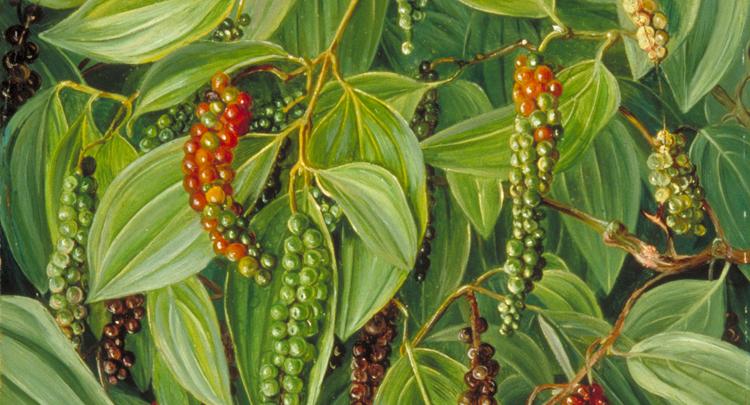
The Latin scientific name of black pepper is Piper nigrum L, which belongs to the order Piperaceae, the Pipeaceae, and the Piper is a wood climbing vine. The stems and branches of pepper are hairless, the nodes are significantly enlarged, and they often have small roots. The flowers are polygamous, usually monoecious. The berries are spherical, sessile, and flowering from June to October. This plant grows in tropical areas with an annual rainfall of 2500 mm, and there is a dry and hot interval in the middle of the growing season. Indonesia, India, Malaysia, Sri Lanka and Brazil are the main exporters of pepper. Its seeds contain volatile oil, piperine, crude fat, crude protein and so on.
OralExternal applicationTreat neurastheniaTreat skin diseasesBlack Pepper garden reclamationSelection and planning of black pepper gardenReclamationPillarPlanting black pepper
Black Pepper morphological characteristics
The leaves of black pepper are very thick, close to leathery, broad ovate to ovoid oblong, rare and nearly round. It is 10-15 cm long, 5-9 cm wide with short pointed tip, round base, and it's often slightly slanted on both sides All hairless. There are 5 to 7 leaf veins, and 9 rare varieties. The uppermost pair is alternate, 1.5-3.5 cm from the base, which originates from the midrib, and the outermost pair is very weak with obvious reticulate veins. The petioles of pepper plants are 1 to 2 cm long and hairless. The leaf sheath is elongated, often half of the petiole.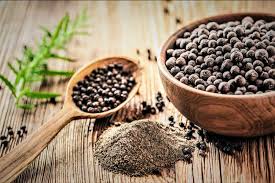
The berry of black pepper is spherical, sessile, 3 to 4 mm in diameter, red when it matures, and black when dried when immature. The flowering period of black pepper is from June to October.
Black Pepper growth habit and growing environment and distribution
Black pepper plants mainly grow in shaded woods. It grows slowly, is heat-resistant, cold-resistant, drought-resistant, wind-resistant, shear-resistant, and easy to transplant. At the same time, this angiosperm is not tolerant to waterlogging. The cultivating soil of pepper plants is best with fertile sandy loam, and good drainage and sunlight are required.
Pepper efficacy and role
Oral
Medically, you can use 1 gram of white pepper to grind powder and add 9 grams of glucose powder to make a powder. 0.3 to 0.5 grams each time for under 1 year old, 0.5 to 1.5 grams for under 3 years old, generally not more than 2 grams, 3 times a day for 1 to 3 days as a course of treatment. If there is dehydration, rehydration is required. 20 cases of simple dyspeptic diarrhea in children were treated, 18 cases were cured, and 2 cases improved.External application
It can be filled the child's umbilical eye with crushed pepper, and apply warm umbilical ointment for 24 hours. If it is not healed, apply it again. Observed 40 cases, all were effective.Treat neurasthenia
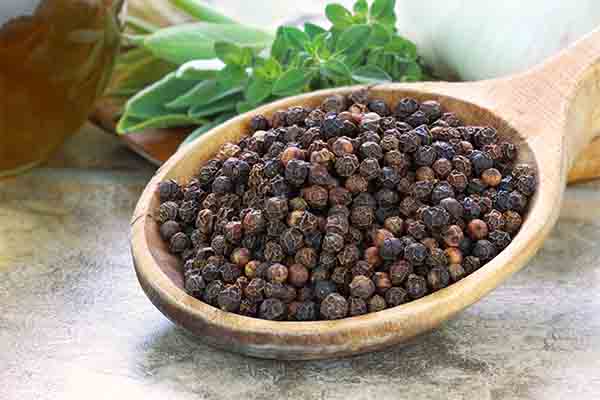
Treat skin diseases
You can mash the purple garlic first, then add fine pepper (2:1) and mash it into a paste. In the treatment, blood was punctured at the vein points on the dorsal ear with a triangular needle. You should cut the epidermis (1~2 cm long vertical incision) in the depression of one helix foot, and cut both ears alternately. Proceed aseptically. Then take the minced pepper and garlic, put it on the tape, and fix it on the incision. The treatment is performed every 4 days, 10 times as a course of treatment with 10 days rest between treatment courses. A total of 219 cases of various skin diseases (neurodermatitis, psoriasis, eczema, acne, neuropruritus, allergic dermatitis) were observed, 156 cases were cured (71.2%), and 56 cases (25.1%) improved. The long-term efficacy needs further observation. Generally, there are no adverse reactions, and only a few patients complain of palpitation and irritability after treatment.Black Pepper cultivation
Gardeners can use good cuttings for planting pepper , and black pepper plants will grow fast, bear early fruit, high yield and long life.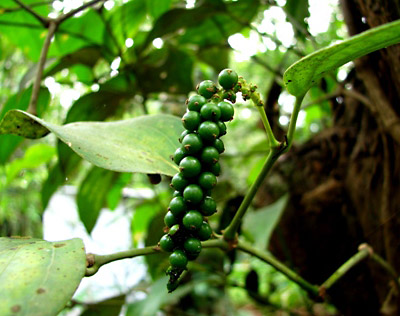
Black Pepper garden reclamation
Selection and planning of black pepper garden
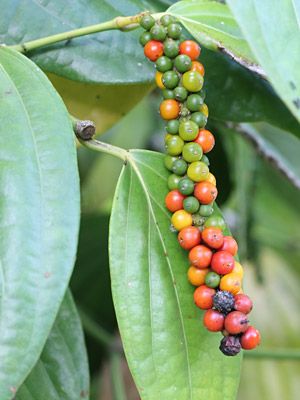
Reclamation
After delineating the protection forest belt, it's time to deep plough 30 cm to remove stumps, roots, debris, etc. in the garden. The large terraces with a slope below 5° have two rows with a field width of 6 meters. You'd better plant a row of small terraces with slopes above 5°. A small drainage ditch was dug inside the terrace. On flat land, gentle slopes and large terraces, ridge planting can also be used to facilitate drainage and disease prevention. The planting hole of pepper is 80 cm wide and 60 cm deep, and the topsoil and subsoil are placed separately when digging the hole. After one month of exposure, return to the soil and apply 30 kg of fully decomposed, clean, finely crushed organic fertilizer, 0.25 to 0.5 kg of superphosphate, and mix it with the topsoil thoroughly and make it into a mound, ready for planting.Pillar

Another type of pillar is a stone pillar. Generally, the stem of the stone pillar is 13-15 cm thick, the end is 10-12 cm thick, and the length is about 3 meters (including 70 cm in the soil part). And the size is relatively uniform. If the diameter of the stone pillar near the ground is less than 12 cm, it is easily broken by a strong typhoon.
Planting black pepper
1. Planting density and period. The row spacing of general pepper plants is 2×2.5 meters. The fertile soil can be 2×3 meters, and the barren land can be 2×2 meters. Planting is more suitable in spring and autumn. The planting of pepper should be carried out in the afternoon on cloudy and sunny days. It is not suitable for planting when the soil moisture is too high.2. Colonization method. The direction of planting should be consistent with the direction of terraces. When planting, the distance from the column is 20 cm, the digging hole is 30 cm deep, and the slope is 50° inclined and compacted. When a single seedling is planted, the seedling is placed against the column. When the double pepper seedling is planted, the seedling is placed in a figure eight shape against the column. The top 1 to 2 sections of each seedling are exposed on the soil surface, and the roots of the seedlings are close to the slope. The gardener should distribute them evenly, stretch them naturally, and then cover the soil to compact them. You’d better apply 5 kilograms of decomposed organic fertilizer on both sides of the black pepper seedlings, and then return to the soil to make a pot-shaped mound in the middle, cover black pepper seedlings with grass, shade and pour root water. Water spray once 1 to 2 days after planting, and the water spray can be gradually reduced after survival. Keep the shade within one year of planting. You must not let the sun damage the black pepper heads and cause the death of pepper seedlings. If there are dead plants after planting, replant them in time. When the pepper seedlings pull out new vines, plant the pillars in time. In addition, you’d better pay attention to loosening the soil, weeding, fertilizing and tying vines of pepper.
Latest Updated
- Benefits of Bugleweed - 7 Science-backed Health Benefits
- Bugleweed Dangers & Side Effects - Is It Poisonous?
- How to Plant Evergreen Trees - What You Should Know
- When to Plant Evergreens - Grow Guide for Evergreen Trees
- 12 Wonderful Evergreen Shrubs for Your Garden
- 12 Popular Evergreen Plants with Pictures for Beginners
- When And How To Prune A Lilac Bush Like a Pro
- How to Grow & Care for Lilac Vine (Hardenbergia Violacea)
- Japanese Lilac Tree (Syringa Reticulata) Care & Propagation Guide
- Shumard Oak Pros and Cons - What to Know
Popular Articles
- Winter maintenance of Antirrhinum Majus
- How to Grow Terminalia Mantaly Tree
- How to Grow and Care for Crossostephium Chinense
- How to grow Antirrhinum Majus in spring
- Peristeria Elata (Dove Orchid) Profile: Info & Care Guide
- Underwatered Snake Plant (Sansevieria Trifasciata) - Signs And How To Fix
- How to Care for Brazilian Jasmine Plant (Mandevilla Sanderi)
- How to Grow & Care for Graptopetalum Purple Delight in Summer
- Rosa Chinensis (China Rose): Plant Growing & Care Tips
- How to Care for Baby Sun Rose (Aptenia Cordifolia)